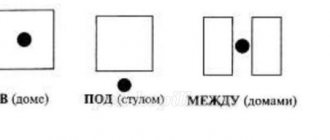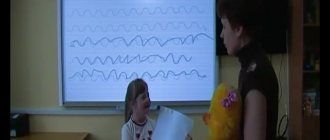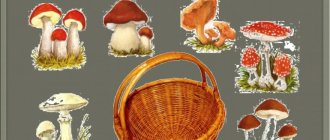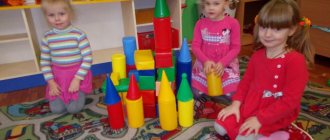Summary of construction and constructive games in the middle group “Teremok”
Summary of construction and constructive games in the middle group “Teremok”
Game development tasks:
- formation of the ability to build a house according to a model.
Developmental tasks:
-improve children’s ability to build a building in a certain sequence;
-fix the names of the parts: brick, block, cube;
-develop the ability to analyze a sample;
-develop the ability to create a strong, sustainable building;
-develop creative imagination;
- develop coordination and dexterity of movements.
Educational tasks:
- to foster creative initiative and independence in the creation of buildings;
Type of construction: construction with building material
Equipment: large wooden building material, tabletop wooden building material, building diagrams; additional material: trees, animal toys.
Preliminary work: Reading the fairy tale “Teremok” and discussing it, D/I: “Whose shadow?”, “Collect a picture”, looking at illustrations for the fairy tale, looking at illustrations depicting bridges.
Progress of the game:
Game "Build Teremok". Children sit on the carpet in a semicircle. Educator: Everyone sit down next to each other and let’s play together. Get your ears and eyes ready, let's begin our fairy tale. There is a tower in a field. He is neither low nor high. Educator: Where is the tower? Where did he disappear to? There are only bricks here. Why do you think? Educator: Teddy bear didn’t want to destroy the house - he just didn’t fit in it. Why do you think? Yes, the house is small, but Mishka is big. So he destroyed it. Educator: I propose to help the residents of Teremok and build it again. Designing, together with children, buildings from parts from a large builder. During construction, the teacher specifies what parts the house consists of, what animals lived in it according to the plot of the fairy tale. It turned out to be a very beautiful little mansion. Who will live in it, since all the animals have fled? Where do you think they hid? Educator: Guys, we will go into the forest and find the animals. To get to the forest, we need to cross the river. How to do it? Educator: Of course, we will build a bridge. What will we build it from?
Construction of a bridge from bricks.
Dynamic game exercise “Narrow Bridge”. Educator: We need to cross the bridge, guys. We will go to the distant forest, Our animals are there!
Physical education minute.
Along a level path, (Walking with high knees) Along a level path, Our feet walk, (Step) Our feet walk, We walked, we walked - And we came to the forest.
Didactic game “Whose shadow?” Educator: Guys, look, the animals hid from us. If we recognize them by their shadows, they will show up and play with us. Children find a colored image of an animal and connect it with a cord to the colored image, saying “This is the shadow of a mouse”, “This is the shadow of a frog”, etc.
Didactic game “Collect a picture.” Educator: All the animals were found. Well done! Now the little animals offer to play with them: collect pictures with fairy tale plots. Whose team completes the task faster will show our friends the way to the new little house. (Children collect cut-out pictures). Educator: As we agreed, the team that was the first to complete the task leads us to the tower.
Dynamic game exercise “Forest path”. Jump through the hole. (Jumping on two legs) Jump over a hole. Jump through a puddle. (Jumping over an imaginary puddle) Jump over a puddle. We walked and walked - we came to the tower.
Construction of "Teremok". Educator: I propose to build each of the animals their own house. Look carefully at these diagrams, choose the one you like and build a house for one of the heroes of the fairy tale. Just be careful, the size of the house must match the size of the animal. Construction according to diagrams from wooden construction table material accompanied by cheerful music. The teacher clarifies what color this or that part of the building is, what shape, what size, how many parts were needed for the construction.
Completion of the game:
Analysis of buildings. Educator: Guys, who do you think Maxim built the house for? (for Mishka). Why? (He is the biggest). We built not only one large Teremok for the animals, where they will all gather together, but also each of them has their own house. It’s good and comfortable for them to live there. They will visit each other. You can play with your buildings and show the story to other toys.
PLAN FOR A GAME WITH BUILDING MATERIAL “FARM”
OUTLINE OF THE GAME WITH BUILDING MATERIAL:
Group
III mixed age
Subject
"Farm"
Type of design:
design on a given topic
Teacher Mikheeva Anna Vladimirovna
Tasks:
- educational: Teach independently, select the necessary parts in accordance with the nature of the building and carry out the construction according to the teacher’s model.
— developing: developing in children the ability to use construction table material and act with it in a variety of ways.
- educational: Develop friendly relationships in the game
Methods and techniques for managing gaming activities:
- verbal: vocabulary work
— visual: building material
— practical: playing with the building
Playing materials and equipment:
Teacher
For each child
Are common
Tabletop building material (bars, cubes, arches), set of Farm toys.
Tabletop building material (bars, cubes, arches), set of Farm toys.
Tabletop building material (bars, cubes, arches), set of Farm toys.
If, during the course of the lesson, children will move around the group room, it is advisable to draw a plan for the placement of the necessary play equipment.
Preliminary work:
Conversation about pets
Individual work
: Playing with different toys representing pets and babies. What animals are called domestic? Why? Who saw a cow, horse and other animals in the village? What are the names of their cubs?
Progress of the game (tactics of game interaction with children):
Start of the game (introduction to the game situation)
Introduction to game rules and actions
Game problem situations for game development.
Completing the game (reflection)
The teacher gives the children a set of Farm toys and invites them to play.
Draws attention to the fact that the animals need to be provided with a safe place so that they do not run away and no one harms them, leading the children to the conclusion that it is necessary to build a fence around the farm.
The teacher suggests populating the farm with small animals (piglets, sheep, poultry) and checking whether the fence is high enough. Then large animals (cows, horses) move in.
The teacher shows a sample of a fence superstructure (the cube alternates with an inverted arch, placed close to each other on top of a fence made of bars).
The teacher asks questions about the farm and offers to play with the building.
Children looking at a set of toys
Children themselves choose the building material (bars) and build a fence by placing parts close to each other.
Children come to the conclusion that the fence is not high enough
Children finish construction
Playing "Farm"
The children became interested in the game and listened with pleasure to the teacher
Children build their own fence
The game continues by fixing the fence
The children learned how to build a fence for animals. Play around the building
Analysis of the game with building materials
Analysis of observation of children's play activities and the role of the teacher
- Compliance of the tasks with the age characteristics of the children.
- What preparatory work was carried out before the game, was it expedient?
- What building material was used in the game (specially created, natural, auxiliary).
- Methods and techniques of stimulation and motivation to play.
- The effectiveness of methodological techniques used during the game and for its completion.
- What type of construction was used during the game, its age-appropriateness, feasibility:
- on a given topic;
- by design;
- according to the conditions;
- "according to models".
- Place and time for the game.
- Children's associations.
- What conditions were created to play around with the buildings?
- Educational orientation of the game.
Analysis of construction game management techniques used by the teacher.
1. Did the game bring joy to the children?
2. Reasons for the achieved result - preparation for the game:
— planning the game (does the program content correspond to the age and level of development of children, is the complex management of the game reflected in the program content;
— creation of conditions (what time is allocated in the daily routine, is there a special place in the group, how is the game equipped);
— preparation of children;
— on whose initiative the game arose;
— whether there was a preparatory period of play in accordance with age;
— are children independent during play or does the game develop with the participation of the teacher;
- what was the guidance of the game on the part of the teacher (techniques, directions);
— did the teacher suppress the children with his interference?
- children’s activities in play;
— how the task of developing creativity, initiative, and imagination in children was solved;
- how the game was completed - organized or unexpected;
— how the analysis was carried out.
3. How would you direct this game?





